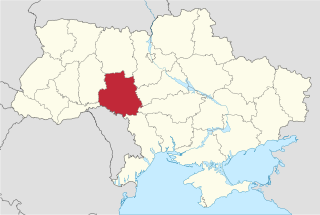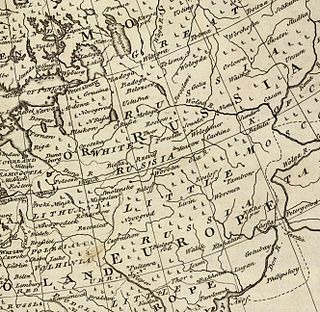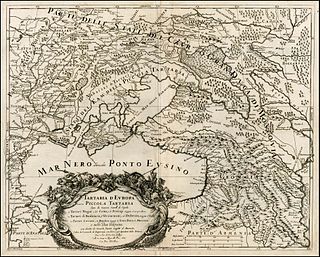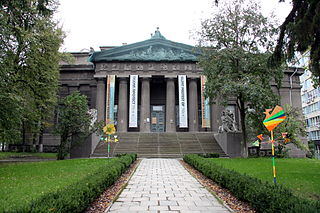This article does not cite any sources .(November 2015) (Learn how and when to remove this template message) |

The Museum of Ukrainian home icons (Ukrainian : Музей української домашньої ікони) of the 16th to 20th centuries is the basic part and main attraction of the Radomysl Castle, a historical and cultural complex which is located in the town of Radomysl (Zhytomyr region, Ukraine).

Ukrainian is an East Slavic language. It is the official state language of Ukraine, one of the three official languages in the unrecognized state of Transnistria, the other two being Romanian and Russian. Written Ukrainian uses a variant of the Cyrillic script.

Radomysl Castle is a historical and cultural complex created in 2007–2011 by Olga Bogomolets MD, a Ukrainian doctor and public activist. The castle's center is an old flour mill built in the town of Radomyshl in the late 19th century by Polish engineer Piekarski. The mill was constructed upon the ruins of a paper mill built in 1612 by the order of the archimandrite (abbot) of Kyiv-Pecherska Lavra Yelisey Pletenecki (1550–1624). During research conducted during the reconstruction of this building, it was discovered that it had been planned to be used as a fortress. Since 2011, Radomysl Castle is part of the Council of Europe’s cultural project called Via Regia, its purpose is to promote cultural exchanges by means of tourism between European countries.

Radomyshl is a historic city in Zhytomyr Oblast (province) of northern Ukraine. It is the administrative center of Radomyshl Raion (district), and is located on the left bank of Teteriv River, a right tributary of Dnieper River. Its population is approximately 14,716 (2017 est.).
The museum’s funds are based upon the private collection of icons collected by Olha Bohomolets, MD, a well-known Ukrainian doctor and public activist. It took nearly 16 years for Mrs. Bogomolets to form the collection (since 1996). This is the first and only museum of its kind in Ukraine and in the entire world, and it is also the largest museum of icons in Eastern Europe. It represents perhaps the largest Christian exposition in Ukraine.

An icon is a religious work of art, most commonly a painting, in the cultures of the Eastern Orthodox Church, Oriental Orthodoxy, the Roman Catholic, and certain Eastern Catholic churches. The most common subjects include Christ, Mary, saints and angels. Although especially associated with "portrait" style images concentrating on one or two main figures, the term also covers most religious images in a variety of artistic media produced by Eastern Christianity, including narrative scenes. Icons can represent various scenes in the Bible.

Olha Bohomolets, MD is a Ukrainian physician, singer and songwriter, Honoured Doctor of Ukraine, the founder and chief doctor of the Institute of Dermatology and Cosmetology.
A Doctor of Medicine is a medical degree, the meaning of which varies between different jurisdictions. In the United States, Canada and some other countries, the MD denotes a professional graduate degree awarded upon graduation from medical school. In the United Kingdom, Ireland and other countries, the MD is a research doctorate, higher doctorate, honorary doctorate or applied clinical degree restricted to those who already hold a professional degree in medicine; in those countries, the equivalent professional degree is typically titled Bachelor of Medicine, Bachelor of Surgery (MBBS).
The icons kept in the Museum are made by both professional and amateur artists. However, their works are equally valuable. Sometimes the artists used Ukrainian Christian folklore as the source of inspiration.
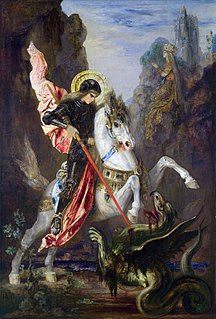
Christian mythology is the body of myths associated with Christianity. The term encompasses a broad variety of legends and stories, especially those considered sacred narratives. Mythological themes and elements occur throughout Christian literature, including recurring myths such as ascending to a mountain, the axis mundi, myths of combat, descent into the Underworld, accounts of a dying-and-rising god, flood stories, stories about the founding of a tribe or city, and myths about great heroes of the past, paradises, and self-sacrifice.

Some icons retain the marks reminding of anti-religious policy and brutal atheism of the Communist dictatorship in Ukraine (traces of fire, slashes, bullet holes etc). Dramatic impression is produced by a chest for wheat made of headless icons.
Atheism is, in the broadest sense, the absence of belief in the existence of deities. Less broadly, atheism is the rejection of belief that any deities exist. In an even narrower sense, atheism is specifically the position that there are no deities. Atheism is contrasted with theism, which, in its most general form, is the belief that at least one deity exists.
The unique attraction of the Museum is a rare icon of St. Nicholas carved in stone in the 12th century. The tradition of such icons comes from the Byzantine Empire and they were used in churches in Rus' up to the 16th century.

The Byzantine Empire, also referred to as the Eastern Roman Empire or Byzantium, was the continuation of the Roman Empire in its eastern provinces during Late Antiquity and the Middle Ages, when its capital city was Constantinople. It survived the fragmentation and fall of the Western Roman Empire in the 5th century AD and continued to exist for an additional thousand years until it fell to the Ottoman Turks in 1453. During most of its existence, the empire was the most powerful economic, cultural, and military force in Europe. Both the terms "Byzantine Empire" and "Eastern Roman Empire" are historiographical terms created after the end of the realm; its citizens continued to refer to their empire simply as the Roman Empire, or Romania (Ῥωμανία), and to themselves as "Romans".
The Museum holds nearly 5,000 items of Ukrainian sacral art from all around the country. Among them are not only Orthodox icons, but also Catholic and Greek-Catholic, including those respected among the followers of different Christian confessions (such as the Holy Virgin of Częstochowa, Berdycziv, Pochaiv etc.).

The Eastern Orthodox Church, officially the Orthodox Catholic Church, is the second-largest Christian church, with approximately 200–260 million baptised members. It operates as a communion of autocephalous churches, each governed by its bishops in local synods, although roughly half of Eastern Orthodox Christians live in Russia. The church has no central doctrinal or governmental authority analogous to the Bishop of Rome, but the Ecumenical Patriarch of Constantinople is recognised by all as primus inter pares of the bishops. As one of the oldest religious institutions in the world, the Eastern Orthodox Church has played a prominent role in the history and culture of Eastern and Southeastern Europe, the Caucasus, and the Near East.

The Catholic Church, also known as the Roman Catholic Church, is the largest Christian church, with approximately 1.3 billion baptised Catholics worldwide as of 2017. As the world's "oldest continuously functioning international institution", it has played a prominent role in the history and development of Western civilisation. The church is headed by the Bishop of Rome, known as the pope. Its central administration, the Holy See, is in the Vatican City, an enclave within the city of Rome in Italy.
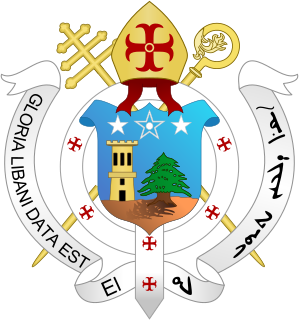
The Eastern Catholic Churches or Oriental Catholic Churches, also called the Eastern-rite Catholic Churches, and in some historical cases Uniate Churches, are twenty-three Eastern Christian particular churches sui iuris in full communion with the Pope in Rome, as part of the worldwide Catholic Church. Headed by patriarchs, metropolitans, and major archbishops, the Eastern Catholic Churches are governed in accordance with the Code of Canons of the Eastern Churches, although each church also has its own canons and laws on top of this, and the preservation of their own traditions is explicitly encouraged. The total membership of the various churches accounts for about 18 million, according to the Annuario Pontificio, thus making up about 1.5 percent of the Catholic Church, with the rest of its more than 1.2 billion members belonging to the Latin Church, also known as the Western Church or the Roman Catholic Church.


